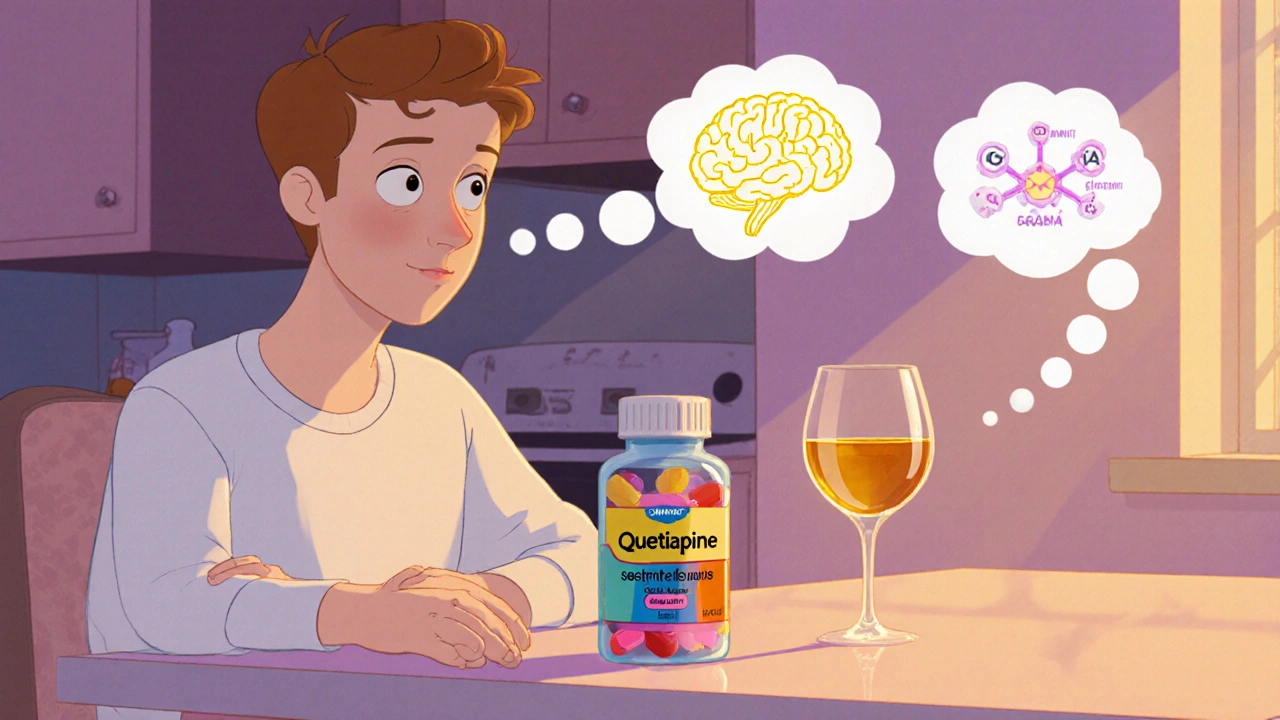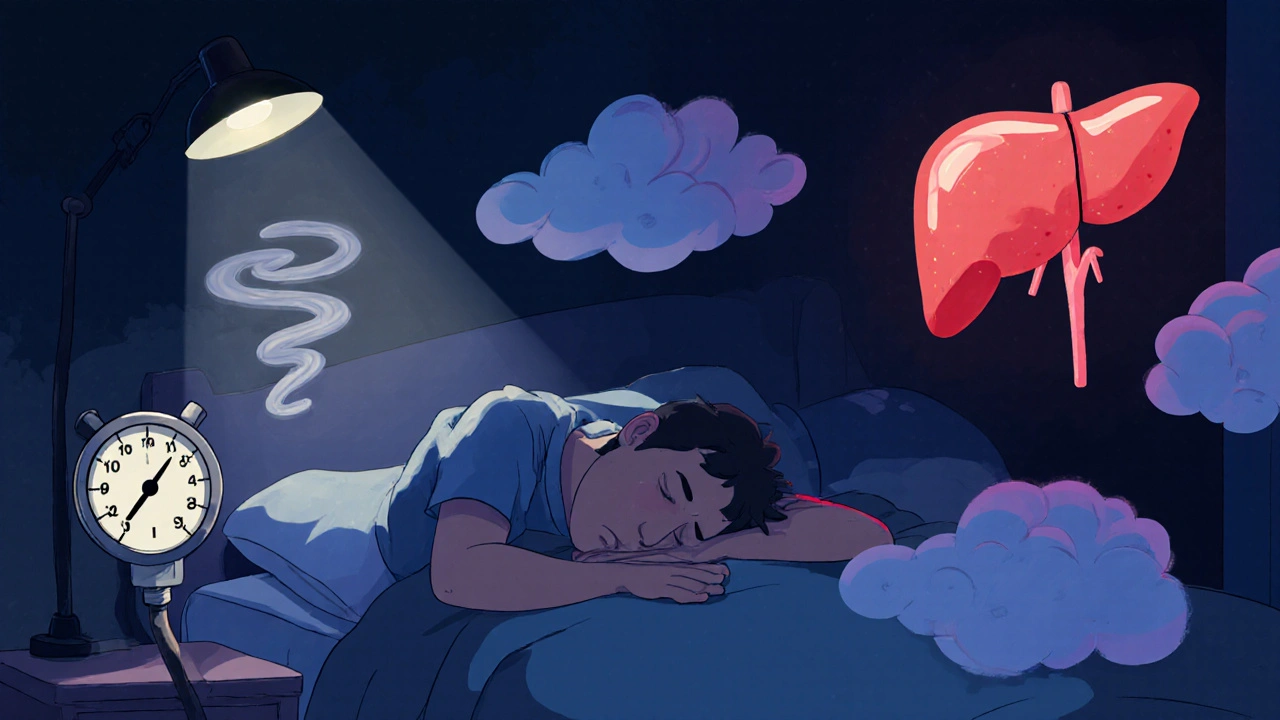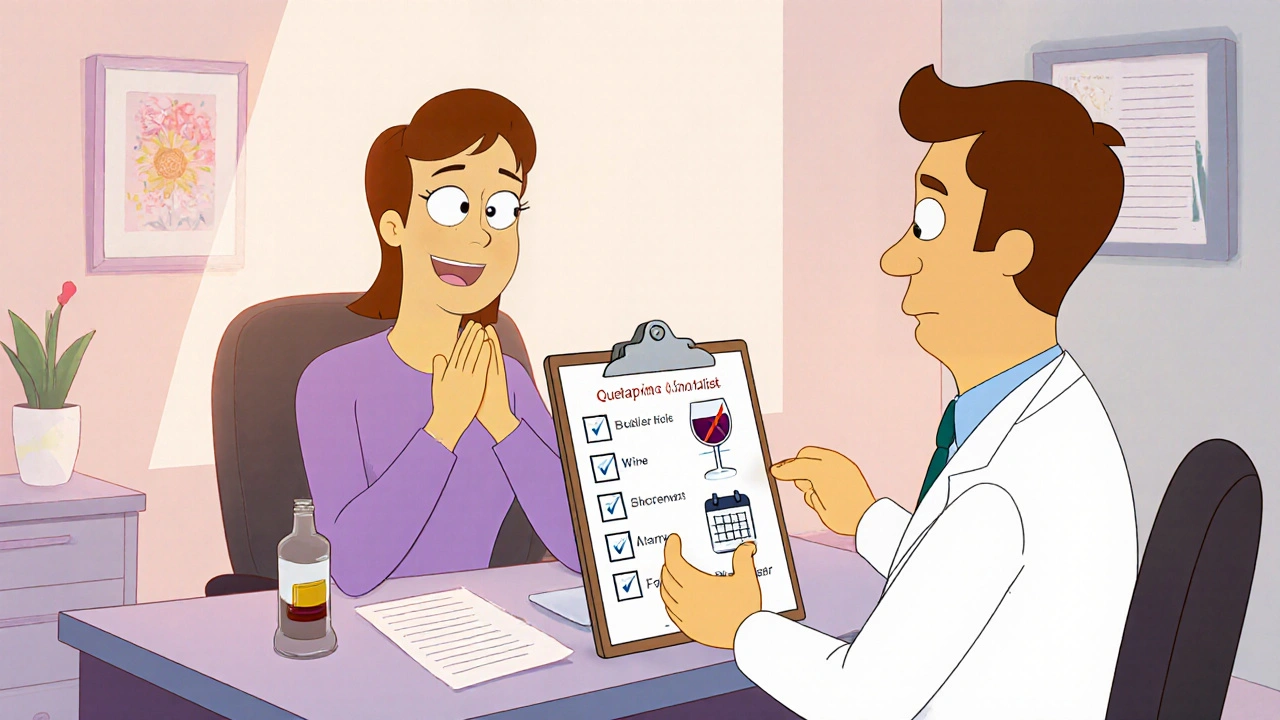Quetiapine and Alcohol: Understanding the Risks of Mixing These Substances
 Oct, 20 2025
Oct, 20 2025
Quetiapine Alcohol Risk Calculator
Your Medication
Risk Assessment
Enter your dose and alcohol consumption to see your risk level.
Ever wondered why doctors warn you not to drink while taking quetiapine? The short answer is that the combo can turn harmless sipping into a medical emergency. Below we break down how each substance works, where they clash, and what you can do to stay safe.
What is Quetiapine and How Does It Work?
Quetiapine is a second‑generation antipsychotic approved for schizophrenia, bipolar disorder, and major depressive episodes. It works by modulating dopamine D2 receptors and serotonin 5‑HT2A receptors, which helps to calm psychotic thoughts and stabilize mood. The drug is metabolised primarily by the liver enzyme CYP3A4, turning the tablet into inactive compounds that are then excreted in urine.
Typical side‑effects include sedation, dry mouth, orthostatic hypotension, and weight gain. Because it depresses the central nervous system (CNS), the medication already makes you feel drowsy or slow‑thinking.
Alcohol’s Impact on the Central Nervous System
Alcohol (ethanol) is a CNS depressant that enhances the activity of the inhibitory neurotransmitter GABA while reducing glutamate‑mediated excitation. Even a single drink can impair coordination, judgment, and reaction time. The liver processes alcohol through alcohol dehydrogenase, producing acetaldehyde, a toxic intermediate that strains hepatic function.
Why the Two Don’t Mix: Interaction Mechanisms
- Additive sedation: Both quetiapine and alcohol lower brain activity. Combined, they can cause profound drowsiness, blackouts, or even respiratory depression.
- Blood pressure drops: Quetiapine can cause orthostatic hypotension; alcohol expands blood vessels, amplifying the risk of fainting or falls.
- Liver overload: CYP3A4 metabolises quetiapine, while alcohol competes for the same hepatic pathways, leading to higher plasma levels of the antipsychotic.
- Impaired judgment: Alcohol blunts your ability to recognise medication side‑effects, making you less likely to seek help promptly.

Short‑Term Risks You Should Know
Within hours of mixing, you might experience:
- Extreme drowsiness or “black‑out” episodes.
- Confusion and difficulty forming memories (anterograde amnesia).
- Loss of balance leading to injuries-common in emergency department reports.
- Rapid heart rate (tachycardia) and palpitations caused by simultaneous CNS depression and compensatory adrenaline spikes.
- Vomiting or nausea, which can increase the risk of aspiration if you’re too sleepy to protect your airway.
In rare cases, the combination can trigger a life‑threatening condition called central nervous system depression syndrome, requiring immediate medical attention.
Long‑Term Health Consequences
Repeatedly drinking while on quetiapine doesn’t just raise acute danger; it also erodes your overall health.
| Aspect | Quetiapine Only | Quetiapine + Alcohol |
|---|---|---|
| Level of Sedation | Moderate (dose‑dependent) | Severe - may lead to unconsciousness |
| Blood Pressure | Slight drop in some patients | Marked hypotension, risk of falls |
| Liver Enzyme Load | Normal CYP3A4 activity | Elevated - risk of toxic quetiapine levels |
| Psychiatric Stability | Generally stable | Increased relapse risk, mood swings |
| Hospital Visits | Low baseline | 3-5× higher emergency admissions |
Over months, the strain on the liver can accelerate fibrosis, especially if you drink heavily. Elevated quetiapine levels also raise the chances of metabolic side‑effects like weight gain and elevated glucose.

What to Do If You’ve Mixed Them
First, stay calm. If you feel dizzy, light‑headed, or notice difficulty breathing, call emergency services (999 in the UK) or have someone drive you to the nearest A&E. Do not try to “sleep it off” if you’re alone; the risk of airway obstruction is real.
When you reach a medical professional, mention the exact dose of quetiapine, the amount of alcohol, and the time each was taken. This information helps clinicians decide whether to monitor blood levels, give activated charcoal, or provide supportive oxygen.
After the acute episode, schedule a follow‑up with your prescribing psychiatrist or GP. They may adjust the quetiapine dose, suggest an alternative medication, or set clear limits on alcohol consumption.
Checklist for Safe Use
- Read the prescription label: look for “Do not consume alcohol”.
- Know your standard drink size (e.g., one 12‑oz beer ≈ 14 g of pure alcohol).
- If you’re in treatment for schizophrenia or bipolar disorder, avoid alcohol entirely-its mood‑altering effects can undo medication benefits.
- Inform your pharmacist about every supplement or over‑the‑counter drug you take; many also use CYP3A4.
- Set up a reminder system to take quetiapine at the same time each day, reducing the temptation to “make up” for missed doses with a drink.
Frequently Asked Questions
Can a single glass of wine ruin my quetiapine treatment?
One small drink may not cause severe problems for most people, but it can still increase sedation and lower blood pressure. If you notice any unusual drowsiness, it’s best to skip the alcohol that night.
Why does alcohol affect the way my liver processes quetiapine?
Both substances rely on the same hepatic enzymes, especially CYP3A4. Alcohol competes for the enzyme, slowing the breakdown of quetiapine and leading to higher blood concentrations.
I started feeling dizzy after a night out-should I stop my medication?
Do not stop the medication abruptly; that can cause withdrawal or symptom rebound. Contact your prescriber, explain the episode, and follow their advice on whether a temporary dose reduction is needed.
Are there any safe levels of alcohol while on quetiapine?
Safety thresholds vary, but most clinicians advise total abstinence because even low amounts can amplify side‑effects. If you must drink, keep it to a single standard drink and monitor how you feel.
What should I tell emergency staff if I’m taken to A&E?
Provide the exact dose of quetiapine, the type and amount of alcohol, and the timing of each. Also mention any other meds or supplements you’re using. This helps clinicians decide on monitoring or antidotes.
Sebastian Green
October 20, 2025 AT 19:46I totally get how confusing it can be when you’re told to avoid a drink while on meds. It’s not just about feeling lazy; the combo can really knock you out. If you ever feel unusually drowsy, it’s better to play it safe and skip the alcohol for that night. Stay aware and take care of yourself.
Kate McKay
October 21, 2025 AT 18:00Hey, just a reminder: staying hydrated and keeping a regular medication schedule can help you feel more stable. If you’re tempted to have a drink, maybe replace it with a non‑alcoholic mocktail and see how you feel. Small changes can make a big difference in how the medication works for you.
Vijaypal Yadav
October 22, 2025 AT 16:13The interaction between quetiapine and ethanol is fundamentally pharmacokinetic.
Both agents are substrates for the cytochrome P450 3A4 isozyme, which means concurrent ingestion creates competitive inhibition.
When alcohol occupies the active site of CYP3A4, the clearance rate of quetiapine diminishes, leading to elevated plasma concentrations.
Elevated levels translate directly into intensified antagonism of dopamine D2 receptors and serotonin 5‑HT2A receptors, amplifying the drug’s intrinsic sedative properties.
Moreover, alcohol’s allosteric modulation of the GABA‑A receptor adds an additional layer of central nervous system depression.
The dual depressant effect can depress the respiratory drive beyond the safety threshold, especially in patients with pre‑existing pulmonary compromise.
Orthostatic hypotension, a known side‑effect of quetiapine due to α‑adrenergic blockade, is exacerbated by alcohol‑induced vasodilation.
The resulting drop in systemic vascular resistance often precipitates syncope, which explains the high incidence of fall‑related injuries in emergency department data.
From a hepatic perspective, the oxidative metabolism of ethanol generates acetaldehyde, a toxic metabolite that depletes NAD⁺ pools and impairs subsequent oxidation reactions.
This metabolic bottleneck further retards quetiapine’s biotransformation, creating a feedback loop of toxicity.
Clinically, patients may present with profound somnolence, blurred vision, and delayed reaction times, impairing everyday functioning.
In extreme cases, the combined depressant load can culminate in central nervous system depression syndrome, a life‑threatening state requiring ventilatory support.
Chronic co‑use also accelerates hepatic fibrosis, as the liver is forced to process both substrates simultaneously over prolonged periods.
Finally, the psychological impact should not be overlooked; alcohol can blunt insight into medication side‑effects, leading to delayed help‑seeking behavior.
Therefore, the safest clinical recommendation remains strict abstinence from alcohol while on quetiapine therapy.
Israel Emory
October 23, 2025 AT 14:26It’s important, of course, to acknowledge the risks, but we should also keep an open mind about individual variability, and consider that not every patient reacts the same way, so personalized counseling is key, especially when dealing with complex drug‑alcohol interactions; nevertheless, the consensus still leans heavily toward caution.
Wesley Humble
October 24, 2025 AT 12:40While your sentiments are appreciated, let us examine the empirical evidence with due rigor. The pharmacodynamic synergy between quetiapine and ethanol is not merely anecdotal; it is documented in peer‑reviewed studies that illustrate additive CNS depression, orthostatic hypotension, and hepatic enzyme competition. Consequently, clinicians must advise abstinence to mitigate iatrogenic harm. 📚😊
laura wood
October 25, 2025 AT 10:53Understanding the cultural context of drinking can help clinicians tailor their advice. Many people see a glass of wine as a social ritual, but when combined with quetiapine, even that modest amount can shift the balance toward danger. It’s wise to respect those traditions while also emphasizing safety, perhaps by suggesting non‑alcoholic alternatives during treatment periods.
Alex Pegg
October 26, 2025 AT 09:06I’d argue the warnings are exaggerated.
Demetri Huyler
October 27, 2025 AT 07:20Honestly, people who cling to outdated prohibition myths about medication and alcohol need to get a reality check. In my experience, most of the panic is driven by sensationalist headlines, not by solid clinical data. Still, a little caution never hurt anyone, right?
JessicaAnn Sutton
October 28, 2025 AT 05:33It is ethically indefensible to downplay the moral responsibility of physicians who fail to inform patients about the synergistic hazards of quetiapine and ethanol. One cannot simply excuse negligence under the pretext of “patient autonomy.” The literature unequivocally demonstrates that such neglect contributes to preventable morbidity.
barnabas jacob
October 29, 2025 AT 03:46Look, the pharmacokinetic interaction is, like, totally a big deal and u shouldnt ignore the whole CYP3A4 competition thing – it’s not just some trivial thing, ya know?
jessie cole
October 30, 2025 AT 02:00Remember, staying safe while on medication is a heroic act of self‑care. If you ever feel uneasy after a drink, reach out to your healthcare team immediately. Your well‑being is the top priority, and taking proactive steps now can prevent serious complications later.